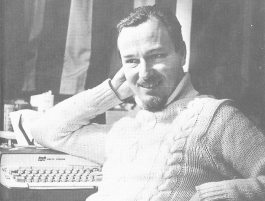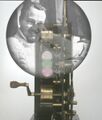John Brunner (nonfiction): Difference between revisions
No edit summary |
|||
| Line 23: | Line 23: | ||
-to name but a few. | -to name but a few. | ||
</blockquote> | </blockquote> | ||
=== Children of the Thunder === | === Children of the Thunder === | ||
| Line 35: | Line 34: | ||
== Nonfiction cross-reference == | == Nonfiction cross-reference == | ||
* [[Stand on Zanzibar (nonfiction)]] | * [[Stand on Zanzibar (nonfiction)]] - a "non-novel" | ||
* [[The Shockwave Rider (nonfiction)]] - 1975 novel | |||
External links: | External links: | ||
Revision as of 06:26, 16 September 2019
John Kilian Houston Brunner (24 September 1934 – 26 August 1995) was a British author of science fiction novels and stories.
His 1968 novel Stand on Zanzibar, about an overpopulated world, won the 1969 Hugo Award for best science fiction novel, and the BSFA award the same year.
In the News
Crime fighter John Brunner uses Gnomon algorithm techniques to detect and expose crimes against mathematical constants.
Marshall McLuhan declines all invitations to form crime-fighting teams, says he prefers academic life.
Excerpts
The Sheep Look Up
Reading, as you might say, from the top down:
Dead satellites.Discarded first and second stages of rockets,mainly second.Fragments of vehicles which exploded in orbit.Experimental material, e.g. reflective copperneedles.Combustion compounds from rocket exhausts.Experimental substances intended to react withstratospheric ozone, e. g., sodium.Very light radioactive fallout.CO2Aircraft exhaust. Medium fallout. Rainmakingcompounds.Smoke.Sulphur dioxide.Leadalkyls.Mercaptans and other bad smells.Car exhausts.Locomotive exhausts.More smoke.Local fallout.Products accidentally vented from undergroundnuclear tests.
Oceanic fluorine.Nitric acid.Sulphuric acid.Sewage.Industrial effluents.Detergents.Selenium and cadmium from mine tailings.Fumes from garbage incinerators burning plastic.Nitrates, phosphates, fungicidal mercuriccompounds from "compacted soils."Oil.Oil-derived insecticides. Defoliants and herbicides.Radioactives from aquifers contaminated byunderground explosions, chiefly tritium.Lead, arsenic, oil-well sludge, fly ash, asbestos.Polyethylene, polystyrene, polyurethane, glass, cans.Nylon, dacron, rayon, terylene, stylene, orlon, otherartificial fibers.Scrap.Garbage.Concrete and cement.A great deal of short-wave radiation.Carcinogens, teratogens and mutagens.Synergistic poisons.Hormones, antibiotics, additives, medicaments.Drugs.Solanine, oxalic acid, caffeine, cyanide, myristicin,pressor amines, copper sulphate, dihydrochalcones, naringin, ergot.Botulinus.Mustard gas, chlorine, Lewisite, phosgene, prussicacid. T, Q, GA, GB, CD, GE, GF, VE, VX, CA, CN,CS, DM, PL, BW, BZ.CO.
-to name but a few.
Children of the Thunder
"He keyed in his fourteen-letter password, which since this was an American database was THEBEERSTOOCOLD, and waited for the screen to light."
Fiction cross-reference
Nonfiction cross-reference
- Stand on Zanzibar (nonfiction) - a "non-novel"
- The Shockwave Rider (nonfiction) - 1975 novel
External links:
- John Brunner (novelist) @ Wikipedia
- John Brunner @ Wikiquotes


